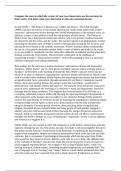Compare the ways in which the writers of your two chosen texts use the narrators in
their works. You must relate your discussion to relevant contextual factors.
In both Wilde’s ‘The Picture of Dorian Gray’ (1881) and Waters’ ‘The Little Stranger’
(2009), narrators are used to reveal sinister details to the reader. Both authors hint at their
characters’ subconscious desires through their skilful manipulation of the narrative voice. In
addition, a sense of inevitability is built into the narrative of both novels. ‘The Picture of
Dorian Gray’ has a third person omniscient narrator, who is the primary mediator between
the characters and the action, and the reader. The narrator speaks in an epigrammatic manner,
mirroring the decadent style of Wilde’s French contemporaries during the fin de siècle, and
placing the novel firmly in the aesthetic movement. Waters’ narration differs substantially;
the use of a first-person unreliable narrator instils a sense of unease and doubt in the reader,
as we are unable to completely trust her somewhat unlikeable protagonist and his ambivalent
feelings towards the Ayres family. Waters herself commented on the challenge of
maintaining Faraday’s ‘bland surface narrative’ whilst still managing to hint at a repressed,
turbulent emotional state lurking underneath.
Both authors use the narrators to expose characters’ subconscious desires and malevolent
intentions. Whilst Waters’ use of a first-person unreliable narrator almost teasingly points at
Faraday’s involvement in the haunting of Hundreds Hall, Wilde’s narrator delves into the
minds of an array of characters, exposing their innermost desires and intentions. Much in line
with Victorian Gothic traditions, Wilde exposes the disturbing private desires that lurk behind
acceptable public faces, particularly through narration of Lord Henry’s intentions towards
Dorian. Soon after meeting Dorian, the narrator states that Lord Henry ‘would seek to
dominate him- had already, indeed, half done so.’ The narrator, in his 3rd person omniscient
point of view, understands the workings of Lord Henry’s mind, and importantly, shares his
foresight into his future intentions. This supports the characterisation of Lord Henry as a
corrupting, influential presence whilst still allowing for equal psychological development in
other characters as the narrator does not adhere to one character. Perhaps Wilde wished to
criticise the superficiality of Victorian society by exposing the manipulative intentions behind
a respected high society figure, as there was a preoccupation with morality and personal
integrity during the Victorian period. However, after preaching about evangelism and
religion, thousands of men visited brothels and many people of both genders engaged in
adultery once they had become bored of their marriage. By using a 3rd person omniscient
narrator, Wilde is completely transparent with his readers about Lord Henry’s subconscious
thoughts and desires, perhaps as a way of hinting that ‘respectable’ society is not as righteous
and virtuous as it suggests it is.
Whilst Wilde uses his narrator to offer full transparency to his readers, Waters does quite the
opposite; through the use of a first person narrator, the reader is left to put together the pieces
that point towards Faraday’s involvement in the hauntings. In exploring the psychological
depths of her protagonist, Waters uses theories developed by Freud in the late 19th and 20th
centuries- this is an element of psychological knowledge which sets her apart from Wilde,
who would not have heard of Freud’s theories at the time he was writing. She skilfully hints
at the workings of Faraday’s unconscious mind, the part of the psyche we are not aware of,
which suggests repressed desires. An example of this is when Faraday states, ‘while i lay
tussling with dark, violent dreams, something dreadful happened out at Hundreds Hall.’ The
use of language such as ‘tussling’ and ‘violent’ hints at a much darker emotional state than
what the reader may have expected from such a bland character. Furthermore, as Freud




